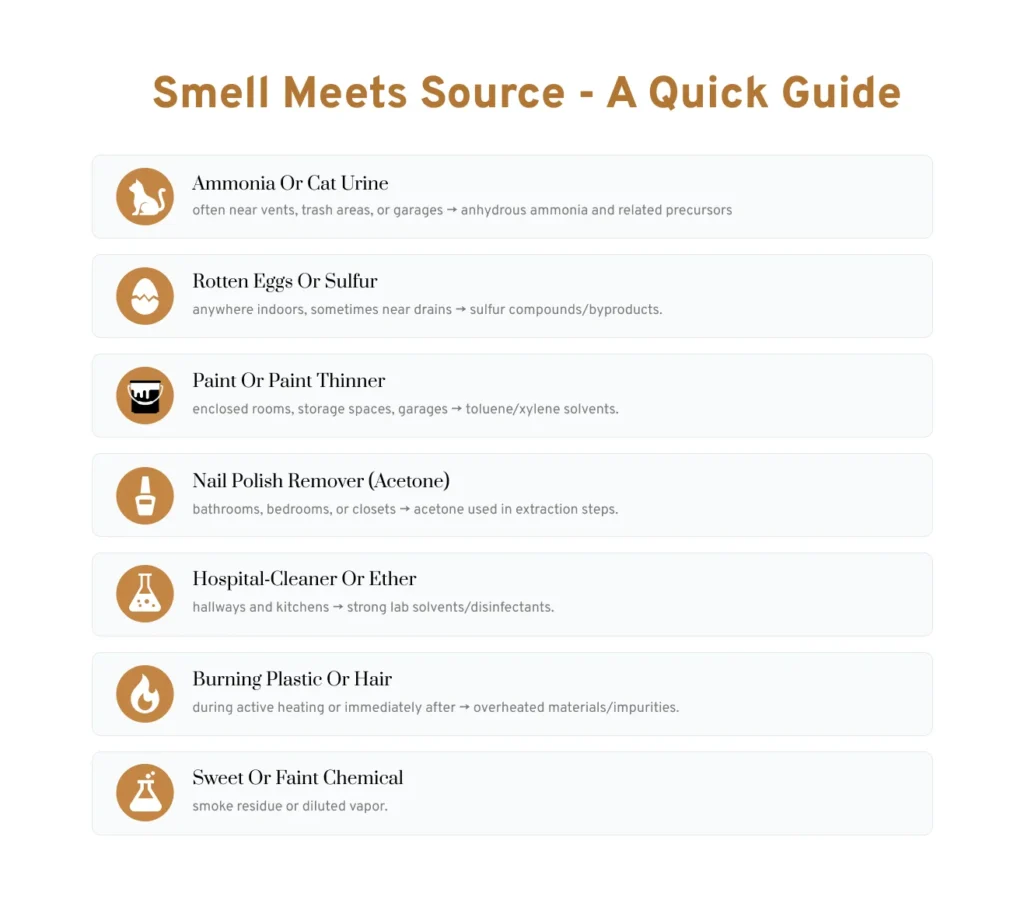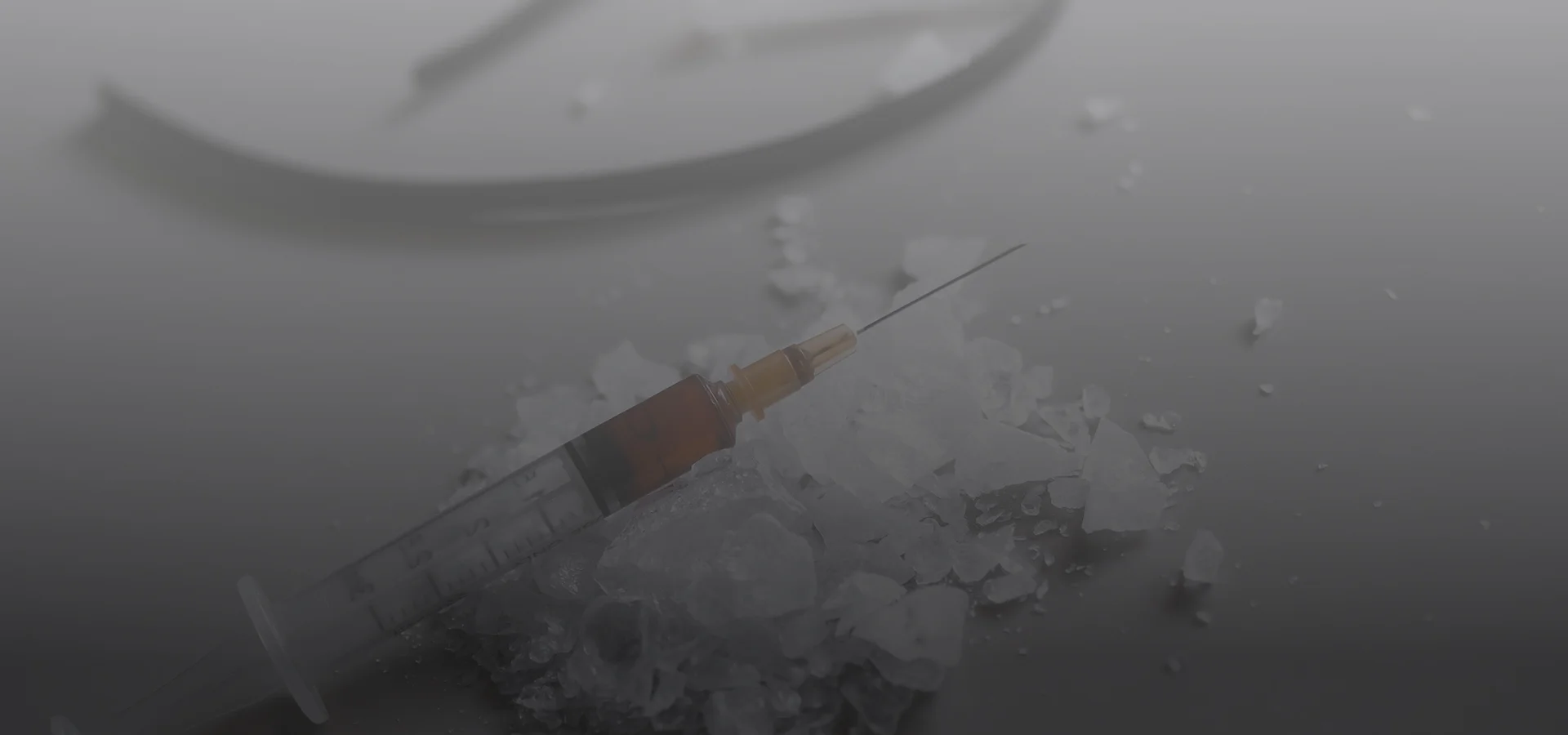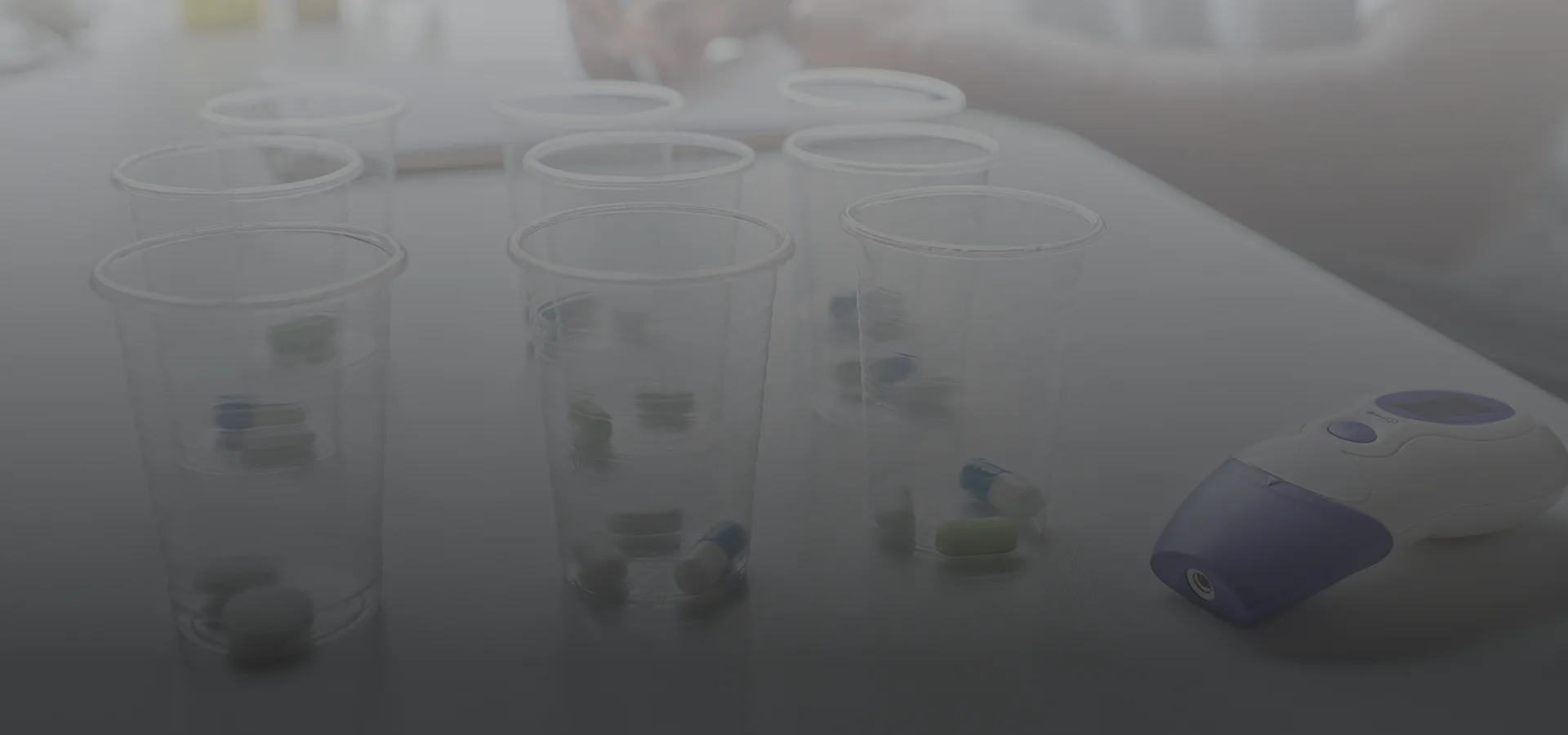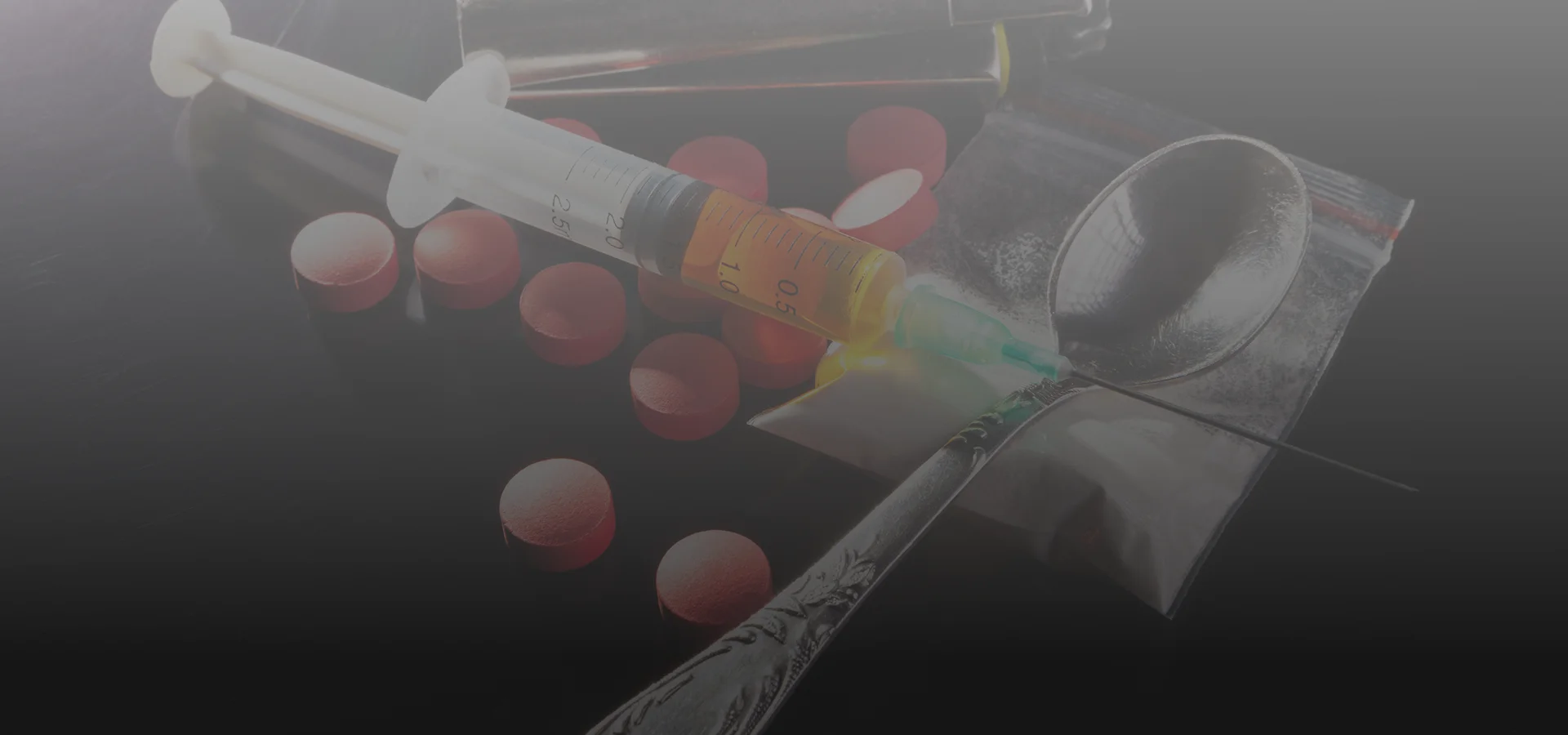Sometimes your nose picks up trouble before your eyes do.
Recognizing what methamphetamine smells like can help you protect yourself, your family, and your neighbors.
Certain odors can hint at active use or even a clandestine meth lab, where volatile chemicals create risks that go far beyond a nuisance smell.
Knowing the signs helps you act early and safely.
Meth vs. Reality (yes, the pun was intended)
Does meth have a smell? The short answer is “often, yes,” but it depends on what you’re smelling: a place where meth is produced, or the softer scent that lingers after someone smokes it.
Meth lab odors tend to be sharp and chemical, while smoked meth can leave a faint, sometimes sweet trace on clothing, curtains, or the air close to the user.
Ventilation, ingredients, and purity change the scent a lot, which is why two homes can smell completely different even if meth is involved in both.

What does a meth lab smell like?
People often describe a meth lab with one or more of these odors:
- Ammonia or “cat urine.” This stinging, eye‑watering smell is a classic red flag and shows up often in official guidance.
- Rotten eggs or sulfur. Sulfur compounds and other byproducts can make a place smell like a gas leak or spoiled eggs.
- Paint or paint thinner. Think toluene or xylene that solvent tang you’d expect in a spray booth or a just‑painted garage.
- Nail‑polish remover or acetone. Sharp and lingering, often noticed in bathrooms and bedrooms where extraction steps may have happened.
- Ether or “hospital cleaner.” A sterile, clinical vibe some people describe as a hospital hallway smell.
- Burning plastic or hair. Harsh, acrid notes can show up when materials overheat.
If those odors cluster with covered or blacked‑out windows, unusual ventilation, chemical containers, or lots of cold‑medicine packaging, step back and call authorities.
Do not investigate. Meth labs can leave behind toxic residues long after production stops.
What does meth smell like when smoked?
Smoked meth is a different story. Many people report a light, almost sweet scent when meth is heated and inhaled. Others notice a faint chemical note, a plastic‑like tang, or a thin metallic edge.
Faith recovery rehab points out that, compared with meth lab odors, smoked meth is usually subtler, especially in well‑ventilated spaces.
This is why you might only notice it on someone’s hoodie, hair, or bedding.
What does meth smell like on someone’s clothes?
Clothing can carry a faint sweet or solvent‑like trace, especially right after use. Fabrics and carpets tend to hold onto these odors longer than open air, so you may notice it in soft furnishings or car upholstery.
What does burning meth smell like?
When the heat is too high or the product is impure, the smell tilts acrid — think heated plastic or a harsh chemical smoke, sometimes with a metallic bite.
What does crystal meth smell like?
Crystal” versus “powder” doesn’t change the basic odor profile. While their scents are similar, the differences between meth vs crystal meth are notable. What you smell depends more on purity, cutting agents, and how it’s made or used. Crystal meth that’s smoked can leave that recognizable light‑sweet or chemical trace; powder that’s snorted or ingested may have minimal scent until it’s heated or produced.
Everyday smells that mimic meth odors
Not every odd scent means methamphetamine.
Common “false positives” include:
- cat litter
- ammonia‑based cleaners
- gas or plumbing issues that smell like rotten eggs
- fresh paint or paint thinner from home projects
- strong bleach
- nail‑salon acetone
Always rule out these everyday sources before jumping to conclusions.
Other clues beyond smell
Odor is helpful, but it’s not proof on its own.
Look for paraphernalia like glass pipes, burned foil, or makeshift filters; unusual residues or discoloration on walls and counters; covered windows or aggressive ventilation; and suspicious trash like torn lithium batteries, solvent containers, or piles of cold‑medicine packaging.
If several clues stack up, treat it as a safety issue and don’t touch anything.
Limitations of methamphetamine smell as evidence
Our noses adapt quickly. You can become nose‑blind within minutes, and some people have reduced smell sensitivity altogether.
On top of that, meth labs often use heavy ventilation or air fresheners to mask odors. Never rely on smell alone; consider the full context and your safety, as well as the long term effects of meth use.
What to do if you notice a meth odor?
Leave the area calmly. Don’t sniff around for confirmation and don’t touch surfaces.
US Environmental Protection Agency suggests observing from a safe place note what you smelled, where, and any other signs like covered windows or chemical containers.
Then use your local non‑emergency number to report concerns. If there are immediate health risks, call emergency services.
Property managers and landlords should be alerted only after you’re safe.
Cleanup of former meth labs requires specialized protocols; do not attempt DIY cleaning.
Smelling the meth odor often?
If you regularly notice what does meth smell like — especially that repeating pattern of ammonia, rotten eggs, or solvent — it might be time to check in on neighbors or loved ones and encourage professional help. Help for a potential crystal meth addiction is available and can lead to a healthier life.
Consider speaking with our team at our drug rehab center in Florida for confidential guidance and next‑step options.
What states or forms of methamphetamine exist?
Methamphetamine isn’t one‑size‑fits‑all. The form can influence how it’s used and where you notice odors:
- Crystal meth ( ice , glass ) clear to bluish shards or rocks, commonly smoked in glass pipes.
- Powder ( speed ) white or off‑white powder, often snorted or swallowed odors are less obvious until production or heating.
- Base a waxy, damp, or oily substance seen in some markets; can have a strong solvent smell.
- Liquid methamphetamine dissolved in liquids for transport or injection; little smell until heated or processed again.
- Pills or capsules less common illicitly, but meth can be pressed or compounded; typically low odor unless cooked or smoked.
These forms share the same active drug. The differences mostly affect route of use and how easily you might detect a scent.
Does meth have a smell?
Yes. Meth odor can be chemical and sharp in production settings, and lighter or slightly sweet when smoked. Ventilation and ingredients affect whether you notice anything at all.
What does smoking meth smell like?
Often a faint, sweet, chemical note that clings to clothing and soft furnishings. In some cases it can lean toward plastic‑like or acrid.
What does meth smell like on someone’s clothes?
A thin sweet or solvent trace. Fabrics can trap these odors longer than open air.
What does burning meth smell like?
Acrid, like heated plastic, sometimes with a metallic edge — usually harsher than the typical smoked scent.
What does crystal meth smell like?
Crystal meth doesn’t have a unique scent compared with other forms. Crystal Meth odor depends more on purity and processing than on the crystal shape.
Is breathing meth lab fumes dangerous?
Yes. Meth labs use toxic, volatile chemicals, and residues can persist. If you suspect a lab, leave and contact authorities. Cleanup should follow specialized guidelines.
If I smell something once, should I call right away?
Trust your instincts. If you catch a clear chemical odor like ammonia or sulfur, or notice multiple warning signs, prioritize safety and call. If it’s subtle or ambiguous, document what you noticed and watch for patterns, but don’t put yourself at risk.
Does methamphetamine always smell sweet when smoked?
No. “Sweet” is commonly reported, but some people notice very little scent or a plastic‑like tang. The smell varies with the product and the environment.


